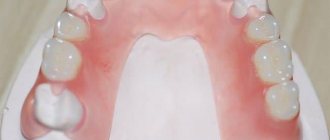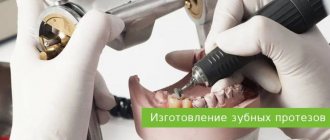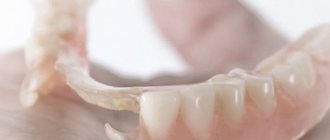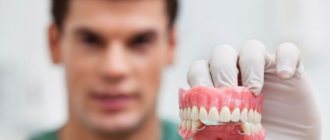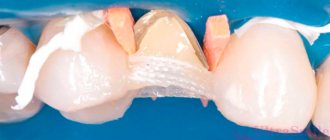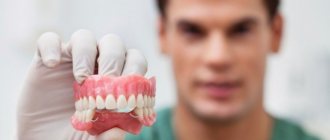In the world of dental prosthetics, an ultra-modern novelty recently appeared - a miniature, comfortable and natural sandwich denture. It suits almost everyone, is easy to clean, and installs quickly and without any problems. Its advantages can be listed endlessly, but it is better to see everything with your own eyes.
Dentistry does not stand still. Specialists are developing new designs and materials that meet modern requirements for aesthetics, comfort, convenience and functionality. This is especially true for implants and dentures, the task of which is to completely replace real teeth. Dental inventions of the new generation include a removable sandwich denture, which is superior to other orthodontic structures in many respects .
Price
- Primary appointment (examination, consultation) with a dentist (special offer) 100001
For free
Promotion
- Prosthetics with partial removable lamellar dentures (up to 3 teeth) 153001
9 900 ₽
- Prosthetics with partial removable lamellar dentures 153002
29 000 ₽
- Manufacturing of removable prosthesis Quadrotti 153006
59 000 ₽
- Prosthetics with removable clasp dentures 153007
59 000 ₽
Removable dentures without a palate are compact orthopedic structures designed to restore the integrity of the upper row of teeth. Traditionally, the upper denture is equipped with a palatal plate for vacuum fixation to the hard palate. Adaptation to such products lasts up to 3 weeks. Some patients cannot get used to it and refuse prosthetics, which reduces their quality of life. A removable denture without a palate is much smaller. The patient gets used to it in 7-10 days.
The history of sandwich dentures
“Sandwiches” are the development of Russian orthopedic dentists with 30 years of experience in practical prosthetics. The specialists took into account all the comments and reviews of patients wearing conventional removable appliances (poor fixation, rubbing of the gums, loss of the “jaw”, lisp, lack of taste in food and nausea). And as a result, they created a removable dental sandwich prosthesis. By the way, it is called that not because it is edible, but because of a special patented manufacturing technology - when materials with different physical properties are combined with each other in a certain sequence.
Why do you need the palate in a removable denture with suction cups?
The simplest dental prosthesis for the upper jaw in the classic design has a palatal septum. The sky cover performs the function of fixation. During installation, air escapes from underneath the device. A rarefied space (vacuum) appears between the soft tissues and the device. The reliability of the fixation depends on the area and tightness of the contact surfaces - the larger they are, the better the hold. Conventional plate dentures without a palate do not hold up well and move during chewing or speaking. But the plate significantly increases the size of the device.
Side effects are:
- diction disorders;
- increased salivation;
- deterioration of taste perception;
- vomiting reflex.
Due to atrophic processes, the alveolar ridge of the jaw gradually sags. A discrepancy appears between the base of the device and the contours of the prosthetic bed. Dental jaws are less stable and the patient has to use special creams.
How it is made
The manufacturing process of a denture of this model is very complex, so the devices are used only in high-level clinics.
The production of the prosthesis is carried out in special laboratories, according to a previously made impression of the jaw of the patient who is undergoing the procedure of replacing teeth with prostheses. The technology for performing the process is unknown, since it is protected by a patent and has not been declassified. After the design is made, the patient is invited to the dentist for a fitting.
During the visit, the finished product is tried on for the patient. If shortcomings and inconveniences in wearing the design are found, it is sent for revision. If the design is ideal in size and shape, the patient is given a form with advice on caring for the dentures to ensure a longer service life.
Features of new generation prostheses without palate
Open-air structures do not have a massive ceiling and are lighter and more comfortable. Therefore they are called new generation prostheses. Due to their compact size, they do not cause discomfort, do not cause a gag reflex, and do not impair diction. With significant absence of teeth in some designs, a small arch is still present for reliable fixation in the mouth. But the septum does not cover the receptors, so taste reactions are preserved. In complete removable dentures, it is impossible to exclude a massive palatal element.
Care
Caring for dentures of this type is quite simple: brushing twice a day with a regular toothbrush and non-abrasive toothpaste, rinsing after each meal, disinfecting with special tablets once or twice a week. It is not necessary to remove the structure at night; you can sleep peacefully and comfortably with it. It is recommended to have your teeth professionally cleaned by your dentist once a year.
Why are we the best
The 32 Dent clinic chain is one of the leading dental services in the Moscow region. The presence of our own dental laboratory, experienced specialists and affordable prices guarantee low cost with excellent results.
Types of partial absence of teeth
Partial dentures have no palatal overlap or include a small palatal septum.
Clasp with metal arc
Partially removable clasp-type devices consist of a metal base, artificial gum, plastic or ceramic crowns, hooks (clasps) or locks (attachments) for attachment to supports. An arc (clasp) passes through the base, strengthening the structure. The devices are equipped with a metal ring or a thin crossbar. The device is fixed to soft tissues and the patient’s own teeth. The advantages of clasp structures are compactness, reliable fixation, and uniform distribution of the chewing load. Splinting clasps allow you to strengthen loose remaining teeth and avoid their premature loss. Disadvantages of clasps - when attached to clasps for fixation, they are noticeable in the smile area, there is a risk of developing galvanic syndrome. Devices of this type are not used in completely edentulous patients. Clasp dentures for teeth function for about 10 years.
Soft Quadrotti
Quattro Ti dentures are made from Dental D plastic.
They consist of dense artificial gum, crowns and a thin polymer bridge. The device leaves a large area of soft tissue exposed.
Due to the absence of metal elements, the design remains lightweight. Fixation is ensured by a tight fit to soft tissues and a clasp mechanism. Transparent hooks are invisible even in the smile area.
Quadrotti dentures are comfortable and aesthetic, so patients quickly get used to them. The material combines the properties of plastic and nylon.
Quadrotti products last 5-7 years.
Acrylic Sandwich
The design includes a base, artificial teeth, and lateral telescopic crowns made of hard material.
The device is fixed on the supporting teeth.
The device can be attached if 2 teeth are intact (1 on each side).
The advantages of Sandwiches are compactness and aesthetics.
Disadvantages - do not use for inflammation of soft tissues, pathological mobility of supporting teeth. Functions up to 5 years.
Immediate prosthesis Butterfly
The Butterfly prosthesis made of lightweight materials is used as a temporary prosthetic option - until the permanent one is ready or while waiting for implants to heal.
It is attached with hooks resembling butterfly wings to adjacent teeth on either side of the defect.
Usually it replaces a short defect (up to 3 teeth), so it does not cover the palate.
Lasts up to 1 year, then requires replacement.
Reviews
Markin Alexey Ivanovich. Moscow
Half a year ago, I placed 4 implants on my lower jaw in Kazakhstan, while they were taking root, in this clinic they made me a temporary nylon removable denture. I paid very little for it and wore it for 4 months until they put crowns on the implants. The prosthetist recommended me a good remedy for cleaning gums and crowns, for which I am very grateful to him, thank you.
Just CALL US!
+7
We will answer any of your questions and will definitely help you!
Is it possible to install a denture without a palate in the absence of teeth in the upper jaw?
Orthopedic devices without a plate are not installed in completely edentulous patients. It is necessary to have a jumper that will hold the device.
An alternative to removable prosthetics is implantation with the installation of a bridge. The most popular technology is All-on-4. The design is completely devoid of a bulky base. Attached to implants fixed in the bone. Implants transfer the load to the bone tissue, which slows down atrophic processes. Prostheses on implants function for 15 years. When using quality materials, the results last a lifetime.
Sandwich prosthesis for dental restoration – how it works, what it looks like and who it’s suitable for
Article navigation
- What is a sandwich prosthesis
- History of creation
- Indications
- Contraindications
- What are the advantages
- Flaws
- Stages of prosthetics
- Service life and care rules
- Guarantee
- Where can I do it?
- Reviews
- Price
Question for a specialist
Sandwich prosthesis is a new product in the field of removable prosthetics. In essence, this is a regular overdenture that rests on the gums. However, it differs from similar designs in the presence of locks or attachments that are fixed in the patient’s own teeth, as well as the absence of palatal overlap. Patients note that the sandwich denture is more comfortable and creates the feeling of having their own teeth in the mouth.
Advantages
The main factors determining the popularity of sandwich dentures are the lack of overlap of the palatal area and the ability to wear the system around the clock. The first advantage allows you to preserve the functionality of your taste buds - practice shows that when using other models, up to 40% of their effectiveness is lost, which reduces the ability to fully enjoy a meal. The second advantage is characterized, rather, by a psychological effect - the patient does not need to constantly get used to the newly installed system, as well as accustom himself to the nightly removal of the structure, which causes awkwardness and embarrassment for those who do not live alone.
In addition, among the positive aspects of sandwich systems it is also worth noting:
- No need to prepare supporting units;
- Fixation without the use of aesthetically unattractive hooks and adhesives;
- Affordable price compared to implantation, as well as production speed;
- Strength and reliability of structures.
Price
The price of a complete removable denture in this category depends on the materials used for its manufacture. The cost range varies from 45 to 60 thousand, and additional costs associated with the examination and treatment of identified pathologies must be taken into account.
Indications for installation
The main recommendation for the use of sandwich dentures is the need to restore the integrity of the dentition. Today, this technique is not the only available method - all other things being equal, implantation still remains the more preferable option. However, in some situations the integration of artificial pins is not possible, and then the advantages of using such models come to the fore. Factors that contribute to a decision in favor of Sandwiches include:
- The patient’s desire to maintain taste;
- Detection of an enhanced gag reflex when the prosthesis comes into contact with the palatine lobe;
- Anatomical structure that eliminates the effectiveness of using suction cups and glue;
- Sensitivity of gum tissue, contributing to the development of pathologies.
The technology does not provide for age restrictions for the installation of removable sandwich dentures without implantation. The only mandatory condition is the presence of at least two of its own immobile units or healthy roots.
Where can such a prosthesis be made?
Where to install a dental sandwich prosthesis? Sandwich structures are manufactured and installed in only one clinic in Russia - the Moscow dentistry "Persona Life". This is where the creators of the patented “sandwich” work. Moreover, the rights to the patent and manufacturing techniques were not transferred to anyone, so the removable “sandwich” is available only to a limited circle of patients living in the capital or having the opportunity to visit it regularly - after all, the prosthesis will have to be adjusted regularly.
Don't know what type of prosthetics to choose?
We will help in the selection, advise where to read more information and compare types of prosthetics.
Consultation with an orthopedic doctor in Moscow clinics is free! Call now or request a call
Working hours: from 9:00 to 21:00 - seven days a week
Contraindications for prosthetics
- allergic reactions to materials: although they are hypoallergenic, no one is immune from individual intolerance. Therefore, carefully monitor the condition of the oral cavity after prosthetics and especially focus on the appearance of rashes, itching, swelling,
- complete edentia (if there are no teeth at all): in this case, instead of “sandwiches”, classic removable ones (plate or Acry-free) are also suitable, but it is better to still carry out implantation - it’s more reliable,
- the need for complete removal of remaining teeth along with roots,
- late stages of periodontitis or periodontal disease, when the teeth become very mobile and cannot serve as a quality support for prosthetics.
Only until 15.01 South Korean implant Osstem - from 18,500 rubles.
Hurry up to sign up for a free consultation and lock in promotional prices.
Call now or request a call
Opening hours: 24 hours a day - seven days a week
Price
Since a removable denture is made from high-quality imported materials, it is expensive and not available to all dental patients. The average price starts from 35,000-40,000 rubles. The cost varies greatly, depending on the number of missing teeth in the jaw and the list of dental services.
What matters is the choice of city, the reputation of the clinic and the specific doctor. If we talk about prices in Ukraine, for example, in Dnieper they start from 10,000 UAH. and higher. But the result is worth it!
Disadvantages of sandwich dentures
Sandwich dentures also have disadvantages. Firstly, they are somewhat more expensive than traditional removable ones, because their production is more complicated. Secondly, they are not suitable for patients with nervous system disorders, or those with allergic reactions to materials. Thirdly, a “sandwich” can be installed only if there are at least two natural teeth in a row, the roots of which are suitable for fastening. However, there is a risk of damage to the supporting teeth - over time, the roots may simply split into pieces due to excessive stress.
Not a single removable denture, even the most modern one, protects the jaw from atrophy (or loss) of bone tissue in those places where tooth roots were previously located, but now they are not there. Over time, the height and width of the alveolar process decreases, and the level of the gum also decreases - so the “pullers” become uncomfortable, begin to shift, and you have to go to the dentist for correction. Now dentistry can offer only one solution to prevent bone atrophy - implant prosthetics.
Stages of prosthetics - preparation, construction and installation
Let's take a closer look at how a sandwich prosthesis on spherical attachments functions and is installed, as well as how it is manufactured.
At the first stage, the supporting teeth are prepared for installation of the prosthesis. The crown is processed, the degree of tooth mobility, the direction of root growth are assessed, and then the nerve is removed from the root canals (but this is not always necessary) and infectious foci, if any. Afterwards, the root is filled and an oval-shaped cavity is created in it. A root spherical attachment is placed inside it, which protrudes above the gum. It is secured with a special fixing material.
At the second stage, impressions are taken, according to which individual prostheses are created in the laboratory. On average, the sandwich dentures will be ready in 2-3 weeks. It is worth noting that the second part of the attachment (which is located inside the prosthesis) is worked out by the dental technician - it is a recess into which the spherical part is placed, located on the supporting tooth. As soon as the two elements are connected, the mount snaps into place and securely fixes the orthopedic structure in the oral cavity.
At the third stage, the sandwich prosthesis undergoes final fitting. If it does not cause discomfort or put pressure on the gums, then the work is considered completed - the doctor will definitely teach the patient the rules for caring for new teeth, and will also explain how to remove and install the denture independently.

